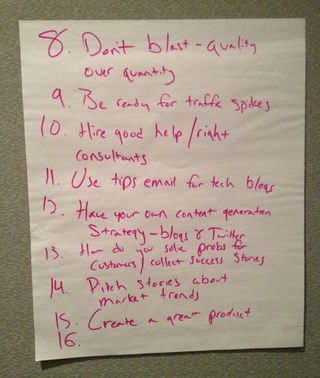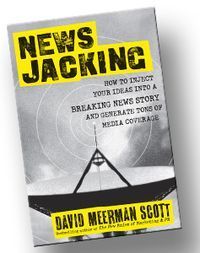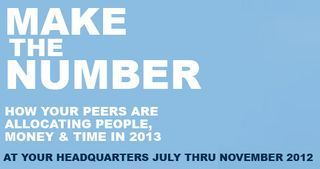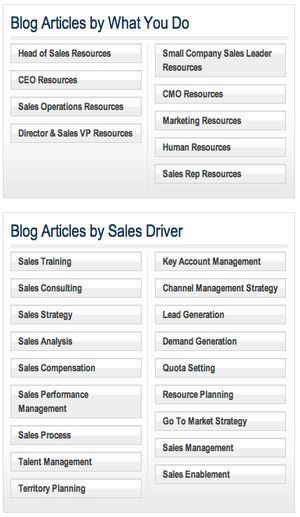David Meerman Scott's Blog, page 79
November 26, 2012
Social networking drives Adagio Teas success
 Adagio Teas is a fantastic example of a company integrating social networking into all aspects of their business.
Adagio Teas is a fantastic example of a company integrating social networking into all aspects of their business.
Social sharing and crowdsourced product creation isn't something that's bolted on as an afterthought at Adagio Teas. Unlike at most companies, social networking is a critical component for driving the Adagio Teas business.
I learned of Adagio Teas from my daughter Allison who was home this weekend from University for her Thanksgiving break. She's a loyal customer and shared with me the cool aspects of how the company works.
Crowdsourced tea blends
As of this writing, Adagio Teas sells a remarkable 24,242 blends of tea. The vast majority of blends are created by their customers either for their own enjoyment (you can keep the blend private) or as one that is sold to others on the site.
Avid tea connoisseurs can search the database for a perfect blend, or like Amazon's bestseller list, browse teas based on popularity. If you like a blend, you can see what other blends that creator has made.
For example, the currently ranked #4 tea Sherlock is a blend by Cara McGee: "All at once exotic and mysterious and perhaps a little bit insane, with a lingering hint of smoke. Inspired by BBC's Sherlock, which I am in no way affiliated with. This is created purely for my own enjoyment. Ingredients: lapsang souchong, assam melody, oriental spice."
Check out the Sherlock blend listing to see the social aspects that are built in. Cara uploaded a video where she talks about the blend, there are customer reviews (187 as I write this), and social sharing including a Facebook "like" button (with 502 thumbs up), tweet this, update Tumblr, and Pin it.
The Sherlock blend is part of a theme that Adagio calls Fandom Signature Blends which also include such teas as Avatar, Big Lebowski, Doctor Who, Harry Potter, & many more.
Your tea profile
Repeat customers can create a profile to keep track of teas they enjoy most and they can also add teas they want to try.
The social aspect kicks in when you add friends to your profile. If you log in to Adagio with a Gmail account, you can instantly find out which one of your contacts also has an Adagio Teas profile. Or if you’re reading a review and like someone's taste in tea, you can friend that person.
Adagio Teas on social media
With all the sharing going on with customers at Adagio, it's no surprise that the company itself is active on social networks. They have an excellent Tumblr official blog from the people behind Adagio and they are active on Twitter with @AdagioTeas, on Facebook, and other social sites.
And they really are active, using social networks to communicate with customers. The mistake made by so many other companies is just using social media like Twitter as a one way broadcast advertising channel. Not so at @AdagioTeas.
For example, recently @AdagioTeas tweeted: “We are developing a wishlist feature & would love feedback. Would you use it as a bookmark for yourself, or as a list to help guide others?”
And people love the interaction. For example, @jamieworley tweeted: "It's so cool that @AdagioTeas sends me twitter DMs to let me know where my tea shipment is!" And it is cool. I wish some of the companies I frequently do business with used Twitter DM to communicate.
Create your own blend
 Over the Thanksgiving holiday, Allison made her own blend because she wanted to have interesting Christmas and holiday gifts for family and friends.
Over the Thanksgiving holiday, Allison made her own blend because she wanted to have interesting Christmas and holiday gifts for family and friends.
The Create a Blend widget is really easy to use. Many people love mixing teas and Adagio has made it fun and easy to mix different flavors to create a unique and tasty blend.
You name your creation and choose the types of teas and the percentages of each. You then have an opportunity to create a custom label that can be just simple text based or something much more elaborate. Social networking pops up again because you can upload a Facebook photo to be part of your custom label.
Allison made a hand drawing for her label, which she scanned and saved as a JPEG and then imported into Adobe Photoshop where she added text and then uploaded to the Adagio Teas app. Her scottea dog blend is "Just a cute jumpy Christmas blend of assam melody, hazelnut, and peppermint".
Points when somebody buys your blend
Another fun social aspect of Adagio Tea is that the creator of a custom tea earns points whenever a customer buys their blend. Points can be used to get discounts or free tea. This encourages social sharing by people who create blends. When your new blend is ready for sale, many people will tweet about or post an image of the label with a link on Facebook or make a Tumblr post talking about the blend.
Driving business success
By building social aspects into all aspects of the customer experience, Adagio teas drives business success. As customers talk about teas on social networks, fan their favorite blends, or even create their own to share with their friends, at each step new people learn about the company. Sure beats traditional advertising to get the word out.
I've learned a lot from this example. It's exciting to see social networking used in such a great way.
Disclosure: My daughter Allison will earn points for anyone who buys her tea. But this blog post is about sharing the great social aspects of Adagio Teas so we can all learn from what Adagio does, not about promoting scottea dog blend.
November 19, 2012
Get Famous Fast: Helping entrepreneurs win at media relations
On Friday, I participated on a terrific panel discussion titled Get Famous Fast: Helping entrepreneurs win at media relations at the MassTLC Innovation 2012 Unconference.
 We had a great crew led by Scott Kirsner, the Boston Globe’s Innovation Columnist and author of Fans, Friends & Followers to discuss this important topic.
We had a great crew led by Scott Kirsner, the Boston Globe’s Innovation Columnist and author of Fans, Friends & Followers to discuss this important topic.
Joining me as panelists were Kate Castle VP Marketing at Flybridge Capital Partners; Dave Balter founder and CEO of BzzAgent; Laura Fitton, HubSpot's Inbound Marketing Evangelist; and Matt Lauzon who co-founded Gemvara.
Since I was participating on the panel and chose not to multi-task, I gathered additional information needed for this report from a few sources including great posts about the panel by Fred Destin (who in true real-time fashion had his post up before the panel was over) Engaging with the Press and Kevin Kosh's Get Rich Fast? Get Over Yourself!, Scott's @ScottKirsner Twitter feed, and the 35 tips the panel created which were transferred to flipcharts (I snapped photos of each of the 5 pages).
While the MassTLC event was primarily for emerging technology companies, the ideas we generated on the panel are valuable for anybody looking to reach the media.
Here are the tips in the order we covered them with liberal post-panel editorial comments from me:
 1 Look at which journalists have written about your competitors. Target them with appropriate outreach.
1 Look at which journalists have written about your competitors. Target them with appropriate outreach.
2 Don't just pitch! Send journalists complements, notes, ideas, feedback.
3 Use Twitter to understand who covers what, what they care about, and what stories they might be working on.
4 Don't underestimate the power of in-person meetings with journalists. I noticed that prior to the conference, Scott tweeted "Up early today. Heading over to the @MassTLC #uncon. Say hello and tell me what you’re up to - esp. if we haven’t met before!"
So had you been watching his feed and then saw him at the event, you knew that it would be cool to say hello. If you did, then you’d have a valuable personal contact with an important journalist.
5 Newsjacking! Use current events as hooks to breaking news. At this point I talked a bit about how to inject your ideas into a breaking news story and generate tons of media coverage.
6 If you update your Google Plus with breaking information that is valuable to journalists, it might get indexed in Google News and be found by them as they are seeking quotes and second paragraph information for their stories.
7 What do your customers read? Read that for ideas.
8 Don't blast your pitches to journalists willy-nilly. Quality is better than quantity.
9 If you are successful in generating an important media hit, be prepared for a spike in traffic to your site and an increase in requests for interviews from reporters at other news outlets.
10 Hire good help and the right consultants.
11 Many news sites have tip lines. Use them when you have something that's important. For example, TechCrunch has the following on the homepage: "So you've got the inside scoop on a story or topic that we've covered? We respect your anonymity. Feel free to directly email us at tips@techcrunch.com"
12 Don't just pitch the media. Have your own content generation strategy! Create videos, blog posts, infographics, Twitter feeds and the like to get your company noticed by the media.
13 Don't just talk about what your products and services do. Reporters don't care. Instead talk about how you solve problems for customers. Journalists love customer success stories, especially if you are giving it to them first (less so if the story is written up on your site for all to see).
14 Don't just pitch about what your company does. How about pitching a story about market trends?
15 The best press starts from companies that have great products.
16 Pitch reporters on your own rather than have agencies do it. Journalists are much more interested if a company founder reaches out to them then if a junior PR rep sends the email.
17 Be able to explain what your company does simply and quickly so that anybody can understand. Revise and rework your "cocktail party explanation" so it is short and simple.
18 Hone in on the essence of what you do with the five why technique.
19 If a journalist responds to your pitch with a request to interview you or wants to receive additional information, RESPOND QUICKLY. Right now. Not five minutes from now – NOW!
20 Make contact information easy to find on your site.
21 Eliminate the gobbledygook. Get rid of all the cutting-edge, mission-critical, best-of-breed, groundbreaking crap language.
22 Early stage companies should hire individual PR consultants rather than firms.
23 Create infographics and videos that tell your story.
24 If you do have an agency, listen in on pitch calls and take a look at pitch emails. Work with agency staffers to get the information right.
25 Conduct due diligence on PR consultants and PR firms you are considering hiring. Speak with their clients and ask about the press the agency helped generate.
26 Think about milestones and big events that a reporter might be interested in such as funding, a product release, the opening of your European office.
27 Reporters are humans. Find out what they like and dislike in their personal life. Find out what they are interested in and writing about and feed them stories that are not related to you. Help them build their stories.
28 What do your customers link to on Twitter?
29 To find the important bloggers in your marketplace, use Google search and Google alerts for long tail search terms.
30 Understand what writers do and what outlets they write for. Many reporters (like me) are what I called "multi-personality disorder types". We don't just do one thing. For example, Scott Kirsner writes a column in the Boston Globe, blog, moderates panels, speaks, founded the Nantucket Conference, has a column in the Boston Globe, is the author of several books, and is active on his @ScottKirsner Twitter! Do a little extra research to find out what the reporter you are targeting does.
31 Retweet bloggers and reporters. Reporters respond well to "heartfelt flattery". So flatter them.
32 Laura says: "Read Meridian by Alice Walker."
33 Know what you represent. Know what your brand is.
34 Negotiate everything up front. If you are offering something on embargo, get the agreement before you spill the beans on the story.
35 Don't lie. Saying "no comment" is okay.
Inside the brain of Scott Kirsner
 Scott spoke for a few minutes and gave a bunch of ideas for what he personally likes and dislikes.
Scott spoke for a few minutes and gave a bunch of ideas for what he personally likes and dislikes.
- Journalists will NEVER fill out a "contact us" form on your press page. They want a real name and number.
- I listen better to people directly involved (the founder, the VC, the angel, a customer) than people paid to pitch (PR).
- In-person connections are where it's at: I want to see companies in their natural habitat, when they innovate, not when they have a PR agency.
- Exclusives: I hate it when Fred Destin lets his stories slip to other outlets.
- Keep it simple: if you cannot explain to me what you do crisply and intelligently without using 3 letter acronyms, I won't engage. Get your cocktail party explanation down! Don't assume I'm an insider.
- Timeliness is everything: once you have someone hooked for a story or if you want to react to one of my questions, do it real time or do not do it at all. And be available for the press!
- Make sure your milestones are newsworthy: launching product isn't. Landing Boeing as a customer, hiring 100 people or getting Jack Welch to be your CEO are.
Panel photo: Ken Kosh via MassTLC blog
Scott Kirsner photo: @ScottKirsner
Flip Chart photo: David Meerman Scott
November 15, 2012
Seattle Police blogs Marijwhatnow guide to legal marijuana use in Seattle
 Here's proof cops have a sense of humor and that the Seattle Police understand the power of online content to educate and inform.
Here's proof cops have a sense of humor and that the Seattle Police understand the power of online content to educate and inform.
On Election Day, November 6, 2012, the people of Washington State passed Initiative 502 making it legal after December 6 for adults over 21 years old to possess up to an ounce of marijuana (or 16 ounces of solid marijuana-infused product, like cookies, or 72 ounces of infused liquid, like oil) for personal use.
So, Washington residents wonder, what does that actually mean for me?
I just love the post Marijwhatnow? A Guide to Legal Marijuana Use In Seattle on the Seattle Police blog SPD Blotter. The post provides a practical guide for what the Seattle Police Department believes Initiative 502 means.
Brand journalism with the Seattle PD
This is some terrific brand journalism!
Here are a few of my favorite Qs and As from the Marijwhatnow post.
Can I legally carry around an ounce of marijuana?
According to the recently passed initiative, beginning December 6th, adults over the age of 21 will be able to carry up to an ounce of marijuana for personal use. Please note that the initiative says it "is unlawful to open a package containing marijuana... in view of the general public," so there’s that. Also, you probably shouldn't bring pot with you to the federal courthouse (or any other federal property).
SPD seized a bunch of my marijuana before I-502 passed. Can I have it back?
No.
What happens if I get pulled over and I'm sober, but an officer or his K9 buddy smells the ounce of Super Skunk I’ve got in my trunk?
Under state law, officers have to develop probable cause to search a closed or locked container. Each case stands on its own, but the smell of pot alone will not be reason to search a vehicle. If officers have information that you’re trafficking, producing or delivering marijuana in violation of state law, they can get a warrant to search your vehicle.
December 6th seems like a really long ways away. What happens if I get caught with marijuana before then?
Hold your breath. Your case will be processed under current state law. However, there is already a city ordinance making marijuana enforcement the lowest law enforcement priority.
Will police officers be able to smoke marijuana?
As of right now, no. This is still a very complicated issue.
The SPD Blotter
 I love the use of humor in the post. Sure, it provides valuable information about the new law, but in a fun and approachable way.
I love the use of humor in the post. Sure, it provides valuable information about the new law, but in a fun and approachable way.
And hey, we're talking about the cops here!
The SPD Blotter began in 2008 and is maintained by the staff of Seattle Police Department Public Affairs Office.
The Marijwhatnow post was written by Jonah Spangenthal-Lee, a journalist who, as he says in his bio, covered “the always-exciting cops and crime beat at Seattlecrime.com, PubliCola.com, KIRO Television, and The Stranger.”
Spangenthal-Lee joined SPD in March 2012 to tell those same stories on the department's SPD Blotter blog and publish real-time information on breaking news through SPD’s @SeattlePD Twitter feed.
Isn't it great that the Seattle PD hired a journalist to write the blog and update the Twitter feed?! I've talked about hiring journalists many times over the years such as this 2009 post An open letter to journalists: You have an amazing career opportunity on the Dark Side.
Here's how Spangenthal-Lee describes his role: "As a reporter, I've stood out in the rain at crime scenes, rode around in patrol cars late into the night, and pored over police reports in order to dig up and tell stories about just what goes on inside the Seattle Police Department, and the streets of our city."
Nice. Maybe I'll have to take a field trip to Seattle to sniff around and learn more about this story.
November 13, 2012
Do you care more about customers or the competition?
Recently, Apple CEO Tim Cook asked Scott Forstall to resign, reportedly because Forstall (who had headed Apple's iOS Software) refused to sign the company's apology over the crappy Apple Maps that were made a part of the latest iPhone software. I'm glad to see that because it signals that Cook cares about customers rather than "beating Google" which as far as I could tell was the only reason to swap out the mapping platform in the iPhone.
Too much focus on the competition
Many companies obsess about the other guys. Why in the world would you name your business Seattle's Best Coffee unless you were directly competing with Seattle, Washington based Starbucks?
My sense is that the various social platforms (Facebook, Twitter, Google+, and the like) are spending way too much time worried about the "competition" and not enough time worrying about their users.
For example, Google worries about Twitter. So Google eliminated the excellent real time search feature which had delivered tweets as part of Google search results. While tweets no longer appear, Google will happily show updates from Google+ in search results.
Who do you care more about – your customers or the competition?
November 9, 2012
In a world of commercialism Free Sofia Tour goes social
 For the past several days, I have been in Sofia, Bulgaria where I delivered a full day New Marketing Masterclass.
For the past several days, I have been in Sofia, Bulgaria where I delivered a full day New Marketing Masterclass.
I always want to poke around when I'm in a city for the first time. So when the good people at Free Sofia Tour tweeted me, I knew I had to be on their tour.
I love how Free Sofia Tour embraces social media while the other tour operators use traditional marketing. I see the other guys' brochures in the hotel lobby. They have ads at the airport and in the tourist magazines. Free Sofia Tour uses social media including Facebook, Twitter, and good old-fashioned word of mouth. I first heard of Free Sofia Tour from Ovanes Ovanessian at Web and Events, who organized my Masterclass.
 Free Sofia Tour relies on volunteer guides like Ina Paunova who showed me, Samuel Bredl, and one other person around Sofia. Talk about social media—both Sam and Ina were booked for my Masterclass.
Free Sofia Tour relies on volunteer guides like Ina Paunova who showed me, Samuel Bredl, and one other person around Sofia. Talk about social media—both Sam and Ina were booked for my Masterclass.
They rely on donations from their guests to support the organization.
Getting social
I just love how this organization works. If you're social, it’s easy to find them. They make you feel welcome, and follow up after the tour.
It’s not just me. Free Sofia Tour is ranked the number one activity to do in Sofia on Trip Advisor with 188 "excellent" ratings out of 200.
In a world of commercialism (think the Big Bus Tours that operate in many cities), sometimes the personal approach works best.
Do check out the excellent Free Sofia Tour web site as well as their @FreeSofiaTour Twitter and Facebook. And if you ever find yourself in Sofia, you know who you should have show you around.
Photo of Ina Paunova by David Meerman Scott
November 5, 2012
Metro Bank is building marketing success through great customer service
 Today at Loyalty World in London, I had an opportunity to interview Anthony Thomson, co-founder and Chairman of Metro Bank. Launched in 2010, Metro Bank is the first new High Street Bank in the UK in 140 years.
Today at Loyalty World in London, I had an opportunity to interview Anthony Thomson, co-founder and Chairman of Metro Bank. Launched in 2010, Metro Bank is the first new High Street Bank in the UK in 140 years.
Anthony shared with me how he made great customer service (and the resulting buzz generated from it) the primary driver of the brand.
Direct link to Metro Bank is building marketing success through great customer service on YouTube.
The market prior to Metro Bank was an oligopoly controlled by a handful of big banks. Anthony told me the customer satisfaction among high street banks was horrible which was the Metro Bank opportunity.
Interestingly, Anthony and his colleagues didn’t look at other banks for market research, instead looked at retailers like John Lewis and Apple that have great customer service.
This led to retail bank branches open seven days a week, 12 hours a day.
Pet friendly!
Metro Bank is pet friendly (which has driven media attention).
I love this quote from the video: "What it says to people is that if they can bring their dog into our bank and we don’t mind if he pees on the floor, or worse which is what dogs do, then maybe we care more about you as a customer than we do about us as a bank."
They even ran a contest where dogs were given samples of three tasty treats and asked to vote for their favourites. The biscuit which has the most votes across Metro Bank branches nationwide was named as the official Metro Bank Dog Biscuit.
Photo: blogs.telegraph.co.uk
November 1, 2012
Outlaw the phrase "Social Media" at work
When I speak with executives around the world about social media and business, many think of their kids' (or grandkids') Facebook or the Twitter silliness they hear about on television.
Frequently, executives come to the conclusion that social media are frivolous at best and a dangerous time-waster at worst. Once they have that in their mind, it is tough to convince them otherwise.
It's not social media. It's real-time media.
In order to scale social, I recommend that we stop using the word "social" and instead substitute "real-time".
When I ask to the same executives about "real-time communications with customers" they lean forward and want to know more. These are the same people who dismiss Twitter.
When I talk about "real-time media" they understand that it is important for their business.
What are people doing on your site right now? Has someone just praised you on Facebook? Panned you on Twitter? Published a how-to video about your product on YouTube? Is there a mainstream media report out about your company?
Executives understand real-time media and are eager to implement the ideas.
If you're having trouble convincing the bosses about the value of social media as communications tools, why not try my semantics trick and discuss real-time media instead? Let me know how it goes.
What say you?
October 30, 2012
When newsjacking is in poor form and can damage your brand
I love the HubSpot blog. Normally, I agree with what they have to say and I frequently tweet links and leave comments. I am an advisor to the company and wrote Marketing Lessons from the Grateful Dead with HubSpot CEO Brian Halligan, so I have deep ties to the company.
HubSpot got this one wrong: 5 Hurricane Sandy Newsjacks From Marketers.
Having written the book Newsjacking: How to Inject your Ideas into a Breaking News Story and Generate Tons of Media Coverage I feel I need to jump in here and offer my take.
When newsjacking is in poor form and can damage your brand
 According to early news reports (I'm writing this early in the morning after the storm hit), Hurricane Sandy has caused $20 billion in economic damage and at least 15 people have lost their lives. A million people have been under orders to evacuate their homes and 7 million people are without power.
According to early news reports (I'm writing this early in the morning after the storm hit), Hurricane Sandy has caused $20 billion in economic damage and at least 15 people have lost their lives. A million people have been under orders to evacuate their homes and 7 million people are without power.
This is not the sort of story to promote cosmetics and fashion, two ideas on the HubSpot post.
These sorts of frivolous newsjacking ideas give the concept of newsjacking (and marketers in general) a bad name because it is a blatant attempt to exploit a tragedy.
Newsjacking is a powerful tool, but you risk unleashing the power in a negative manner that can seriously harm your brand if you exploit something in poor taste like a major storm. Kenneth Cole learned this lesson the hard way when he attempted to newsjack the revolution in Egypt.
You need a legitimate tie to the story
 To be successful, attempts at newsjacking must have a legitimate tie to the story, especially when the story is about a disaster, death, or any other negative. The examples in the HubSpot blog post about marketers relating fashion and cosmetics to Hurricane Sandy are in the Kenneth Cole category.
To be successful, attempts at newsjacking must have a legitimate tie to the story, especially when the story is about a disaster, death, or any other negative. The examples in the HubSpot blog post about marketers relating fashion and cosmetics to Hurricane Sandy are in the Kenneth Cole category.
The HubSpot post also references a tweet by Sears pointing to supplies they sell that could be useful in the storm’s aftermath such as generators. This is an example of a legitimate tie and something that is valuable.
Sears would really nail it if they offered a real-time store search feature so consumers could find out if their local store had supplies such as batteries and generators. I could see that being picked up in the media and benefiting Sears.
Newsjacking
I'm thrilled that the ideas in my Newsjacking book have become popular with marketers. As an author, that's the ultimate – having others take your idea and run with it. But newsjacking is tricky. We’ve got to work together to show not only the positive side, but the potential pitfalls as well.
October 26, 2012
Metrics to Show How a Content Marketing Editorial Calendar Drives New Business
This is the third in a three part series on how professional services firm Sales Benchmark Index has made the transition from traditional outbound marketing like cold calls to a content-driven marketing approach using blogs, twitter, ebooks, and videos. I conduced several lengthy interviews with I love the approach Greg Alexander, CEO of the company to learn the inside scoop. If you haven’t done so, read the first installment Professional Services Firm Grows 50% through Switch from Outbound to Inbound Marketing and the second How to Target Buyer Personas with the Right Content Created Especially for Them.
Content based on the buyers' business
Greg knows from his buyer persona research that 75 percent of his US potential clients are on a calendar-based planning cycle. "July through October is when they go through their annual operating plan," he says. This is the time that buyers are most receptive to Sales Benchmark Index services and when the majority of sales tales place. "They are trying to figure out things like how many sales people do I need? How should I place the territories? What should the quotas be? How should I pay them? A lot of the research is centered around those issues."
Because Greg's sales happen July through October, he has a calendar-based approach to content creation.
"From November through June the approach is to give away lots and lots of intellectual property to built up the subscriber base," Greg says. "We believe that permission to have a conversation with buyers is a valuable asset. Within the blog we will write about a problem. We'll offer up a tool that we used with one of our clients to solve that specific problem. All we ask is that they click on the link. We put it behind a form, and then they get the tool for free. During the November through June time period, we don’t bombard them with follow up marketing activity."
 As the subscriber roles grow, Greg's team shifts focus during the selling season when buyers have a greater need for information because they are planning next year's budgets from July through October. "During that time period, we shift the focus of the blog to having subscribers participate in our annual research tour, which we call Make the Number: How Your Peers Plan on Allocating People, Money and Time for the Upcoming Year."
As the subscriber roles grow, Greg's team shifts focus during the selling season when buyers have a greater need for information because they are planning next year's budgets from July through October. "During that time period, we shift the focus of the blog to having subscribers participate in our annual research tour, which we call Make the Number: How Your Peers Plan on Allocating People, Money and Time for the Upcoming Year."
Make the Number allows potential clients to have a personal review of benchmarking data and research. "This is an onsite seminar," Greg says. "If you want access to all these tools, and you've been a subscriber of ours for months and sometimes years, one of our experts will come on site and give you a presentation for 90 minutes to the executive team on kind of a set of best practices heading into the new year. So it allows somebody to compare and contrast the sales strategy before the New Year begins."
Greg has had tremendous success with the calendar approach to content creation. "Just to give you some stats here on the power of content marketing, in prior years we might do between 50 and 100 visits during the July to October period," he says. "But this year, we'll have done over 220 of them. We know that about half of them eventually, inside of six quarters, become clients of ours. When people buy a professional service like ours, it's intangible. So we use the Make the Number meetings to turn what we do into a tangible by actually introducing people face to face. It makes it easier for the buyer to buy."
Measuring success
 I love how Greg's team measures every aspect of his content efforts. After all, this is a company that helps sales and marketing executives be more effective, so you can imagine how they focus on measuring the effectiveness of their own inbound marketing.
I love how Greg's team measures every aspect of his content efforts. After all, this is a company that helps sales and marketing executives be more effective, so you can imagine how they focus on measuring the effectiveness of their own inbound marketing.
In fact, they measure down to the blog post level (something that they learned from HubSpot, whose marketing software Sales Benchmark Index uses). "We grade posts based on things like how closely each are related to the problems of our buyer personas," he says. "We count the number of words in sentences, targeting six and 14 words per sentence. And we grade the effectiveness of the title. Then there are the hard metrics like the number of comments and social shares and links generated, and view counts."
Greg also analyzes what he calls "branded versus non-branded keywords" looking at how many people come to the blog on a monthly basis for each. A branded keyword is when somebody hits the blog for a term like "sales benchmark index" (they entered the company name into Google). A non-branded word would be if somebody searched on "sales territory design".
"Important phrases for us include 'territory design,' 'lead management', and 'sales incentive compensation'," Greg says. Note how these terms are fairly specific, but not so long tail as to be obscure. They specifically target 'lead generation' as a term because the phrase is so competitive. "We go after 'lead management', and we’re doing better as a result of that. We're looking at the number of incoming links and we use the HubSpot Link Grader Search Engine Optimization Tool. This year we've generated 579 new domains linking to us with 27,780 individual links that came from those domains. The thing that I'm probably the happiest about is the quality of the links has gone up. HubSpot graded the links earlier in the year at 47 on a scale of zero to 100. Now the average link rate is 82."
I wanted to know about the ultimate success measure, so I asked Greg how revenue was tracking. "We're up over a little over 50 percent this year," he told me. "That's our revenue number and our head count, which in professional services is a key metric. In consulting, utilization numbers are really important, too and we're running at 80 percent utilized right now, which is great. I can directly attribute much of that gain to inbound marketing and content marketing."
Advice to other organizations on how to implement inbound marketing
With his measurable success, I wanted to know what advice Greg would offer to other CEOs interested in adopting a inbound marketing content strategy.
"This is a mental shift to realize that you're really in the publishing business," Greg says. "If you embrace publishing, then the transformation that we talked about here will happen. If you're a CEO and you still believe that you're in another business, I don't believe you're going to make that transition. Unless you grew up in the publishing world, there’s much to learn. It's a steep learning curve. I've spent my time studying how successful publishing companies build their business. I understood things like audience acquisition and things I never knew about before. It helped quite a bit. You've got to learn how to be an effective publisher."
Disclosures: Greg and I serve together on the Eloqua board of advisors, which is where we met. In addition, I am on HubSpot advisory board and serve as Marketer in Residence at HubSpot.
October 25, 2012
How to Target Buyer Personas with the Right Content Created Especially for Them
This is the second in a three part series on how professional services firm Sales Benchmark Index has made the transition from traditional outbound marketing like cold calls to a content-driven marketing approach using blogs, twitter, ebooks, and videos. If you haven’t done so, read the first installment Professional Services Firm Grows 50% through Switch from Outbound to Inbound Marketing.
Subject matter experts
I love the approach Greg Alexander, CEO of the company, has taken to building content. Since Sales Benchmark Index is a professional services firm with smart subject experts, they needed to create an environment to channel the expertise into the creation of blog posts, videos, and longer form content assets like ebooks.
"We heavily explored the use of contractors and agencies and went so far as to request work product samples from them," Greg says. "What we found was very, very talented writers, smart people, great art directors and all of those good things. But they just really couldn't grasp the details of what it is that we do. So the content they were producing was too generic. It wasn’t relevant enough to our audience, so we decided to build internally."
Greg's "internal agency" includes three staff: a full-time editor who manages an editorial calendar, the production schedule, and determines media channels; an SEO expert to increase the likelihood of the content getting found in search; and a copywriter, who works with subject matter experts inside the firm. "But the actual writers, the contributors of all the content are the subject matter experts in our company who are working with our clients," Greg says.
Buyer personas
Interestingly, the subject matter experts at Sales Benchmark Index are organized by buyer persona. I always recommend this buyer-centric approach yet very few companies organize around buyers, instead focusing on the product lines they offer rather than the personas they sell to.
"It was a difficult transition for us," Greg admits. "We used to be service offering focused. In fact the entire company was organized that way to where we had P&Ls by service offering. I had to break that because I agree with your philosophy. It was a painful transition and it took us some time to get there."
Greg also does what I recommend everyone do—he not only developed buyer persona profiles, but also named his buyer personas. At Sales Benchmark Index there are nine buyer personas, and there are two people from the firm assigned to work with each one and to create content for them.
"For example, we have a persona called 'Big Company Mark', Greg says. "Big Company Mark is the chief marketing officer or the VP of marketing. We have two individuals in our firm who have been serving the chief marketing officer in the B2B environment for many years, even prior to joining our company. They were the ones who actually constructed the buyer persona, so they understand what their needs and challenges are. For example, one of our service offerings is lead generation. But we didn't want to just write about lead generation because that was very much an inward out perspective. We found that people really don’t care about us. They care about themselves. So if you can write about lead generation through the eyes of the chief marketing officer inside, say, a telecommunications company or software company, it resonated more. So that's how we have the teams organized."
Developing compelling content
 When it came time to start writing, the team started with a blog. They worked with HubSpot to deploy the HubSpot marketing platform to host the information.
When it came time to start writing, the team started with a blog. They worked with HubSpot to deploy the HubSpot marketing platform to host the information.
"It started slowly," Greg says. "Our early blog posts probably weren't our proudest moments. But then we started to build interest and get subscribers. Soon everybody in the company saw the success and wanted to participate, so we began posting to our blog every day."
In a nod to real-time marketing, the company blog is actually the homepage. This is a terrific way to showcase company expertise and also to surface content for SEO purposes. "Our best asset is our blog," he says. "So we thought, why not put that on the homepage? That really helped." In a world where so many organizations treat their homepage like the cover of a brochure, having blog posts that update daily occupy that valuable real estate is excellent real-time marketing.
One thing I particularly love about the Sales Benchmark Index home page is how the blog posts are organized in an index that is both buyer persona based and also market problem based. Brilliant! This means potential customers can find exactly the posts that are created for them.
The team at Sales Benchmark Index also creates long-form content including an ebook targeted to newly promoted VPs of sales Promoted to VP of Sales: The Year One Toolkit. "That's done extremely well for us," Greg says. "It was a heavy lift for us to put it together. But it has created over 4,000 leads for us so far this year. We also launched a monthly webinar series with one of our subject matter experts and a Q&A session. We've gotten about 1,000 attendees per month for that."
Greg is personally active on Twitter with his @GregAlexander feed having nearly 35,000 followers. The company feed @makingthenumber is over 30,000 followers and many all the subject matter experts in the company have their own personal Twitter accounts. "We ask our people to be active on Twitter and we’ve seen significant increases in our follower count," he says. Greg says LinkedIn is the most effective social platform for the company, even more important than Twitter.
With all these successes, I wanted to know what didn't work. "Facebook was a total failure for us," Greg says. "We gave it a college try, invested a lot in it. In fact, I was so frustrated that I hired a consultant to help me with it, somebody who explored all the possible options for us. Our customers and target audience did not want to engage with us there. But we tried. That’s our approach, throw a wide content net and let the process of elimination consolidate around the areas that worked out well."
In tomorrow's post, I'll discuss how Greg measures success and provide his advice to other CEOs on how to get started with a inbound marketing content strategy.
Disclosures: Greg and I serve together on the Eloqua board of advisors, which is where we met. In addition, I am on HubSpot advisory board and serve as Marketer in Residence at HubSpot.



